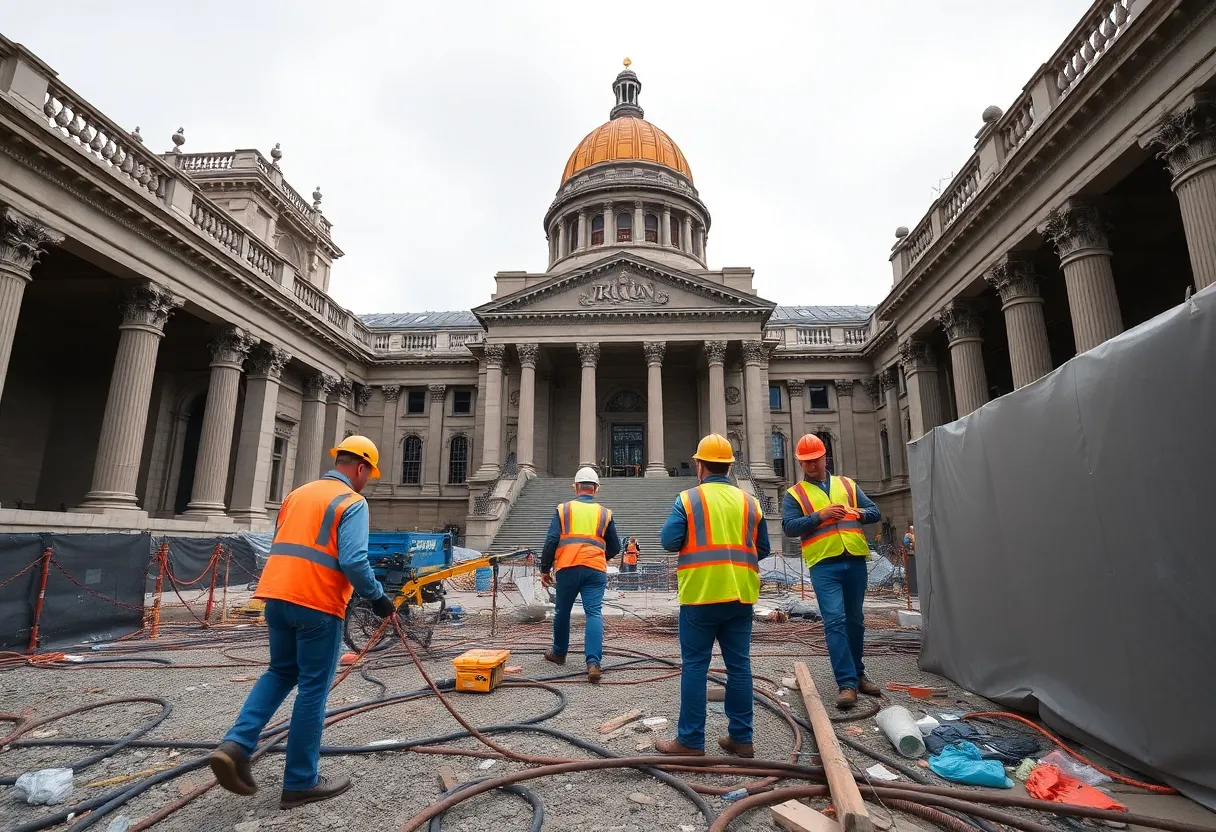News Summary
Asbestos removal operations are in progress at the Oregon State Capitol without prior notification to lawmakers or visitors, as part of a renovation project.
Asbestos Removal Underway at Oregon State Legislature Amid Lack of Notification
In a developing story, asbestos removal operations are currently taking place at the Oregon State Capitol in Salem without prior notification to state lawmakers or visitors. This crucial procedure is part of a larger effort to modernize the historic building, originally constructed in 1938.
Ongoing Renovation Project: A $505.7 Million Initiative
The Oregon State Capitol is undergoing an ambitious $505.7 million renovation project known as the Capitol Accessibility, Maintenance and Safety (CAMS) project. Now in its third phase, construction began in April 2022 and is expected to be completed by the second quarter of 2026. The entire project is spearheaded by Hoffman Construction under a sizable $397 million CMGC contract.
Key Features of the Modernization Efforts
The ongoing renovations aim to enhance several critical aspects of the building, including seismic retrofitting, a redesigned basement with four new hearing rooms, and a cozy café area for visitors and lawmakers alike. Upgrades to fire suppression systems and the removal of hazardous materials such as lead pipes and asbestos are also part of this extensive overhaul.
Impact on Legislative Operations
According to Jodie Jones, the CAMS project director, the closure of the 1938 building has strained operations across the campus. The simultaneous demolition and construction of various systems have presented significant challenges in maintaining fire and life safety. Ensuring the safety of lawmakers and staff while addressing the growing issues related to ongoing construction has proven to be a demanding task.
Complexity of Structural Modifications
The project faced unforeseen difficulties, including the removal and addition of temporary structural supports. Contractors have used approximately 2,500 tons of steel to ensure stability during construction. Additionally, modifications had to be made to earlier seismic retrofits, requiring the installation of thicker shear walls and more robust structural connections.
Phased Development Approach
The CAMS project has been strategically developed in three phases. The initial phase, approved in 2016 at nearly $60 million, focused on compliance with the Americans with Disabilities Act and upgrading mechanical, electrical, and plumbing systems. The second phase, which followed in 2020 with a budget exceeding $70 million, addressed crucial seismic structure improvements in the building’s 1977 wings.
Future Plans and Milestones
Looking ahead, the anticipated milestones for the project include the relocation of occupants back into the upper floors by early 2025 and a hopeful completion of the concourse level alongside the overall project by early 2026. Despite the ongoing renovations, the Oregon state government continues to operate effectively during this massive construction effort.
Nevada Legislative Building: A Similar Renovation Story
In a parallel effort, the Nevada Legislative Building in Carson City is also undergoing significant remodeling, with renovations costing an estimated $25-$30 million. This extensive project is focused on modernizing facilities and ensuring safety through necessary asbestos abatement and lead removal operations.
Comparison of Both Projects
This Nevada project, authorized by lawmakers during a special session, is designed to feature a new secure entrance and various modernization updates. Construction oversight is managed by Plenium Builders, with design contributions from local architects Paul Cavin and Ethos Three. The expectation is for the west entrance of the Nevada Legislative Building to be completed before the next legislative session in 2025.
Emphasis on Safety and Accessibility
Both the Oregon and Nevada legislative projects underscore the critical importance of safety, accessibility, and modern infrastructure in state legislature buildings. As these renovations progress, the attention to detail in ensuring compliance with safety standards and improving accessibility will serve as a template for future projects across the nation.
As the situation develops, more information on both renovation projects will likely emerge, shedding light on the impact these updates will have on legislative functions and the well-being of those who work within these historic halls.
Deeper Dive: News & Info About This Topic
HERE Resources
Asbestos Concerns Rise in North Carolina Amid Legislative Building Controversy
The Latest Breakthroughs in Mesothelioma Treatment: A Pipeline Insight
Dr. Michael Jones: A Life Cut Short by Mesothelioma
Vivace Therapeutics Secures $35 Million for Mesothelioma Drug VT-3989
HER2DX Study Revolutionizes Treatment Paradigms in HER2-positive Breast Cancer
Shipyard Worker Fights Asbestos Exposure in Court
The Asbestos Market: An Unfolding Story of Opportunity and Challenge
Residents of Li’l Abner Mobile Home Park Face Urgent Relocation Amid Asbestos Concerns
Coldwater City Council Takes Major Steps to Tackle Asbestos Concerns
The Ongoing Battle Against Asbestos: A Toxic Legacy in the U.S.
Additional Resources
- WRAL: Work Underway to Remove Asbestos at State Legislature Building
- Wikipedia: Asbestos
- MSN: Asbestos Removal at North Carolina Legislature
- Google Search: Asbestos Removal Legislative Building
- ENR: Historic Upgrade of Oregon Capitol
- Encyclopedia Britannica: Renovation (Architecture)
- Nevada Appeal: Remodel Underway for Nevada Legislative Building
- Google News: Nevada Legislative Building Renovation



















